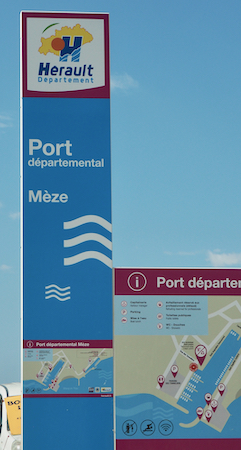
|
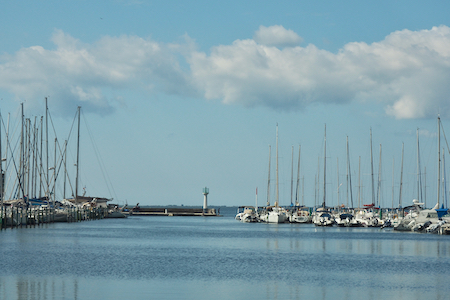
Harbor at Meze |

Boat in need of work!
|

Marina
|
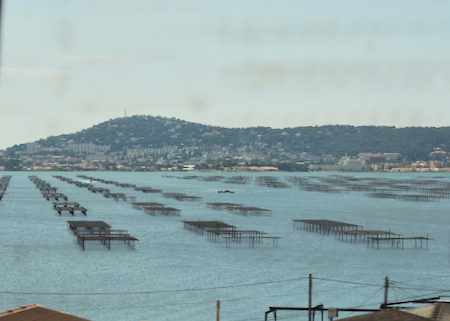
Oyster/Mussel farm
|
Next stop was the city of Orange, a place occupied by the Romans from 40 CE to the 6th c. They laid out the N-S and E-W main streets and built the baths, theater, aqueduct, sewer system, etc. A local guide took us into the Roman theater that was rediscovered in the 19th c. Over the centuries, houses had been built in the seating area and orchestra and these were removed and the theater rebuilt.
The marble that once covered the limestone walls has mostly been taken away and the limestone is wearing away. There is a debate as to whether restoration should take place or not. Our guide told us the Romans presented three kinds of theater performances: attulane with four identifiable characters, an old man, a hunch back, a hungry man and a nasty man and the audience could easily identify them (kind of like Punch and Judy); pantomime, and mime. Only mime had female actresses.
|

Roman Theater at Orange
|
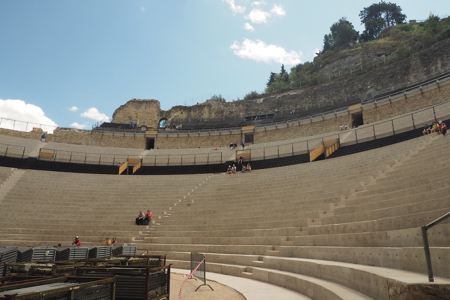
Modern seating for 9,000 people |

Stage
|

Ruins of a roman Temple next to the theater
|
Nuclear power plant. France has 19 of them and they provide 70% of the country’s electricity. |
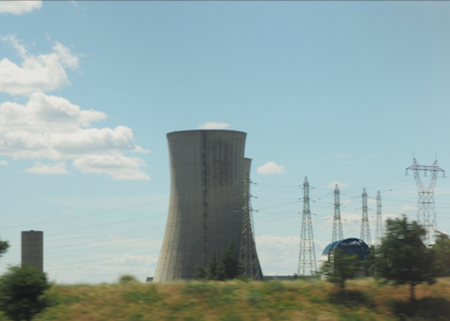
Nuclear power plant
|
There was heavy traffic on the toll road to Lyon. The same was true as we entered the Lyon city traffic and crept along.
Lyon is an industrialized city and is the second largest in France - after Paris. The Saone and Rhone Rivers and their confluence are within the city. The Romans settled in here around 43 BCE and set the street plat and usual Roman city buildings. The Roman theater and odeon ruins remain. Lyon is known for gastronomy, silk weaving, and French resistance in WWII.
|
Wed., 6/8/22 - Lyon
This was a more than 10,000 steps day that started when we met our excellent local guide at Place de Comedie, the square with the 19th c. opera house. The first two stories of the opera house are traditional but the top is a modern black dome that houses practice studios and such. It looks like, and is referred to as, the “Toaster.”
The front of the old city hall, in the Place Terreaux, are: the museum of fine arts, that was originally a large convent for noble women; a large metal fountain designed by Bartholdi who made our Statue of Liberty; and a series of fountains shooting water three feet high along the middle of the square.
|
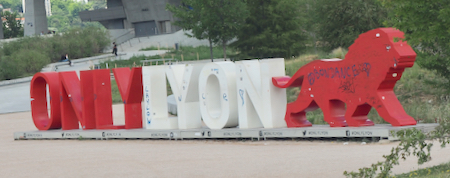
City sign |

Graffiti along the Rhone river.
Half-circle-shaped building in the background is the new opera house, called the Toaster by locals.
|
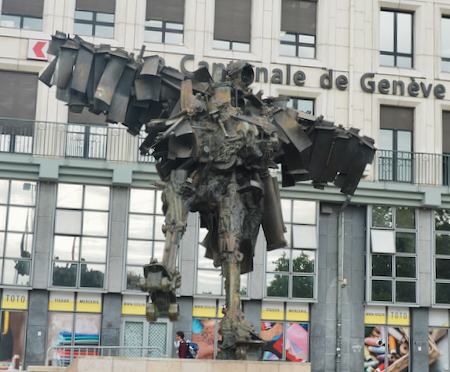
Le Patineur - The Skater - by Cesar Baldaccini
The sculpture represents a man with wings, wearing roller skates and balancing on one leg.
|
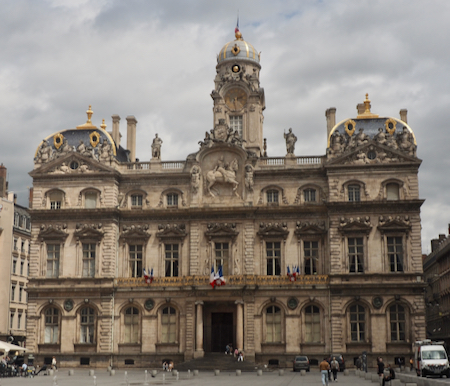
City Hall
|
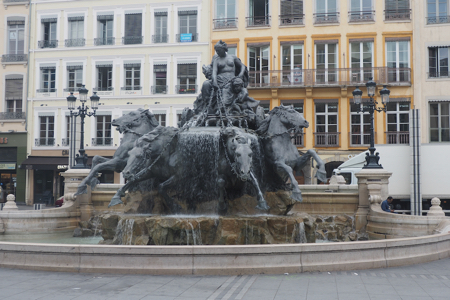
Fontaine Bartholdi in the Place Terreaux |
 
Fine Arts Museum
|
Our guide lead us down a small alley of Bouchon shops. These are beer and sausage type cafes where people meet and talk sports or politics. At Cafe Des Federations we stopped for a tasting experience that consisted of salty fried pig fat (like chitlins); two types of sausage, a spam-like mix, and sour pickles; a sausage that looked more like baloney with pistachios (the skin could be peeled off) served with a gravy of pig blood, vinegar and shallots; and two cheeses, one was like sour cream with vinegar, garlic and shallots and the other similar to a mild brie. The cheeses were good with the bread. And, of course, red wine, at 9:30 in the morning.
|

Alley of Bouchon shops
|
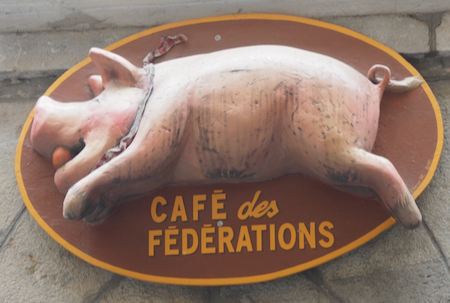
|
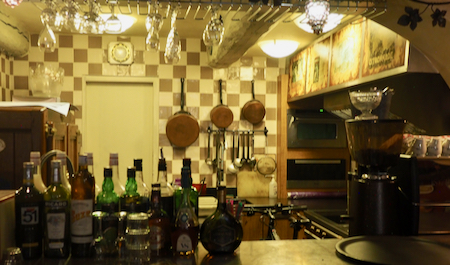
Cafe Des Federations - kitchen |
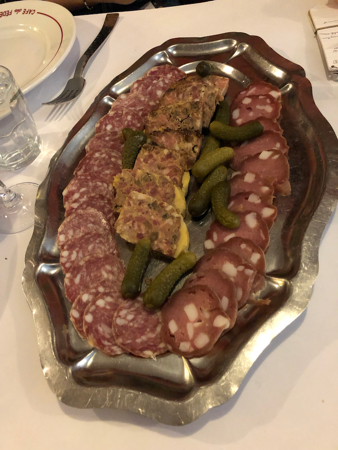
Two types of sausage, a spam-like mix, and sour pickles
|
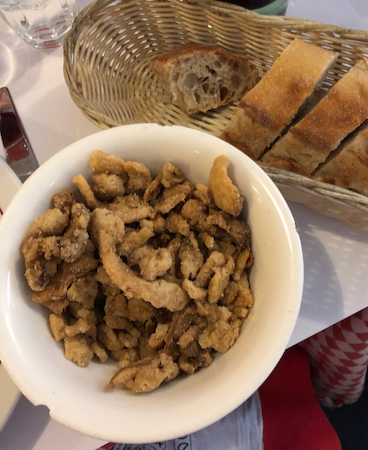
Salty fried pig fat (like chitlins)
|
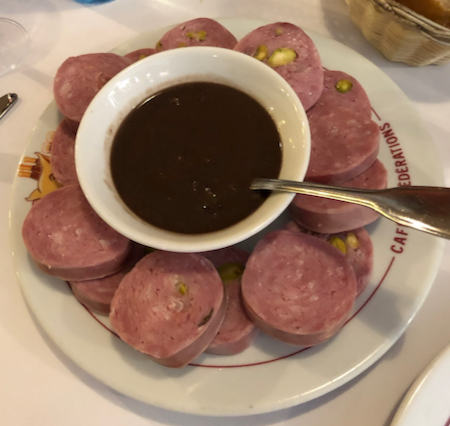
Sausage with pistachios served with a gravy of pig blood, vinegar, and shallots |
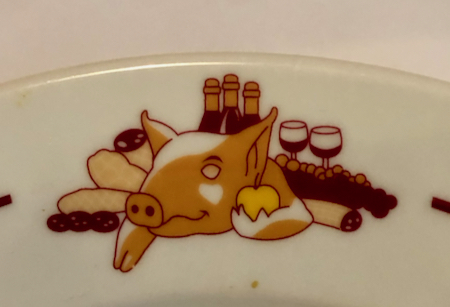
Cute logo on the plate |
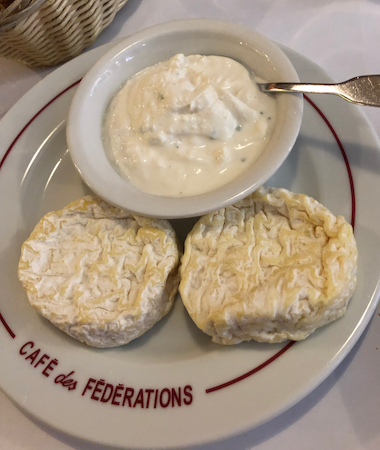
Cheeses
|
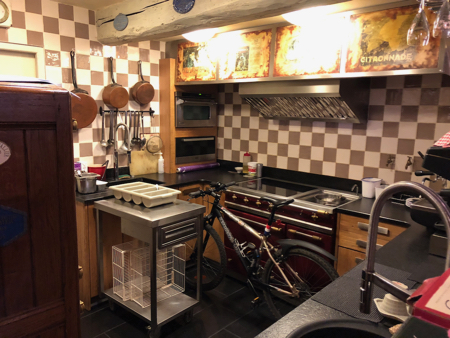
Bicycle in the kitchen |
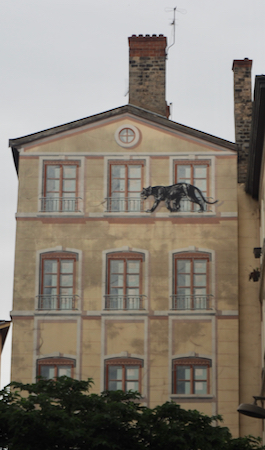
Painted building façade
|
Our walk continued across the Saone River to the oldest part of Lyon. On the way we saw several buildings with walls painted to make it look like a façade or interior of the building, including the Library - La Bibliotheque De La Cite painted to look like shelves of books.
We stopped in a candy store and sampled special Lyon candies - red sugar coated nuts, nugget, and several other candies. All were very good.
Another stop was a “Learning and Discovery” at a silk shop. Basically they silk screen designs on silk scarves which sell for €70 to €170! They have some silk worms making cocoons but they buy most of their silk already as thread. They weave them in different thread counts for different textures, i.e., 1 vertical and 3 horizontal silk threads done on looms. They also combine silk and velvet in patterns that are very unique. The silk is then dyed and the velvet hand painted. The owner then showed us a number of ways to tie and wear her scarfs. A very interesting small business.
|
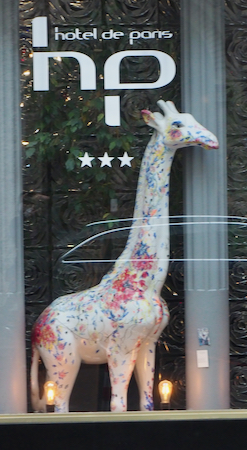
Another nice giraffe
|
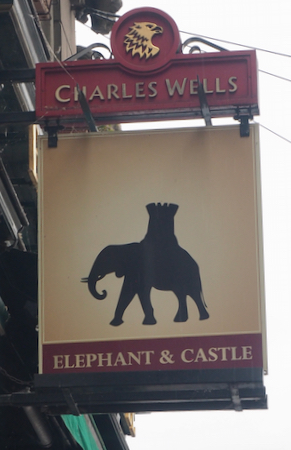
Pub sign
|

La Bibliotheque De La Cite - façade
|
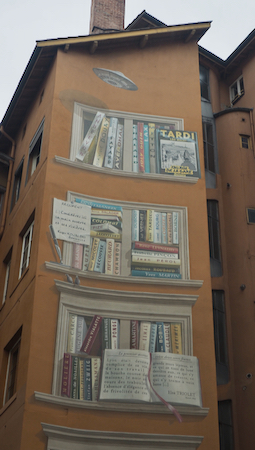
La Bibliotheque De La Cite - façade
|
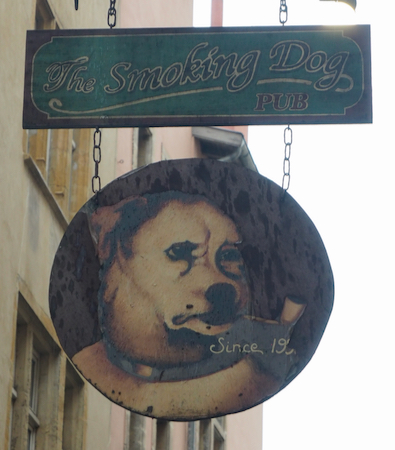
|

Men beware! This works, as shown on a rainy day
|

Puppet store
|
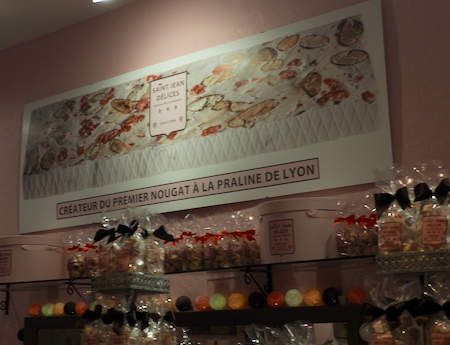
Candy store |
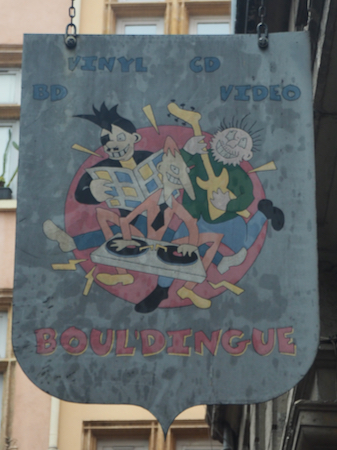
Music store
|
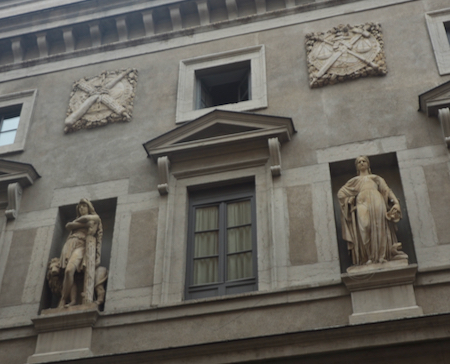
Building Façade |
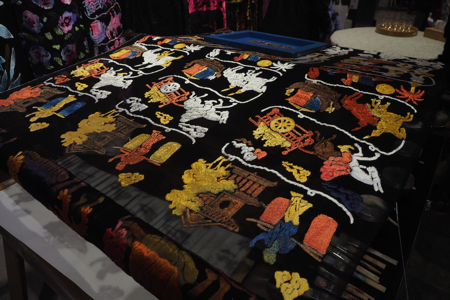
Silk shop
|

Silk worms
|
The old town is interesting. There are the usual narrow cobblestone streets and boutique shops but there are “push doors” that lead to a narrow passage (a traboule) which is parallel to the streets. In the middle of the passage is usually a small courtyard with a well and spiral staircase giving access to the apartments above. These are convenient short cuts and helped the Resistance move from place-to-place during WWII.
|

Door to a Traboule
|

Another nice sign - inside the traboule |
A €3 funicular ride took us up to the basilica on Fourviere Hill.
Our Lady (Notre Dame) de Fourviere is a large, opulent church. It has mosaic floors and large mosaic and gilded walls of scenes from crusaders’ battles, and religious depictions. The ceiling and pillars are all carved, painted, covered in gold, etc. In the crypt is a collection of Madonnas: Afrique, Black, Japanese, Guadeloupe, and a painting of the Shroud of Turin.
|
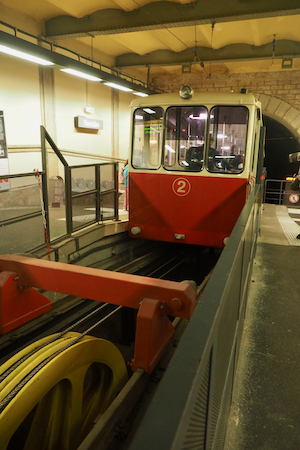
Funicular to Fourviere Hill
|

Funicular tracks
|
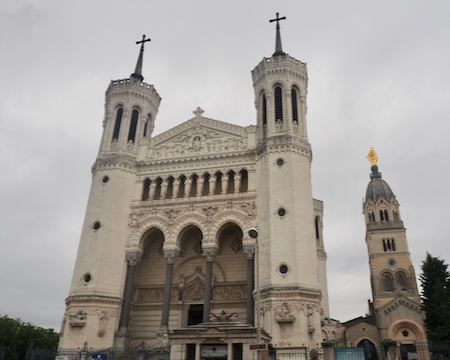
Our Lady (Notre Dame) de Fourviere Cathedral
|
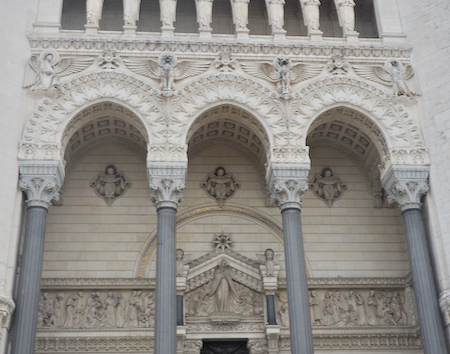
Entrance detail
|
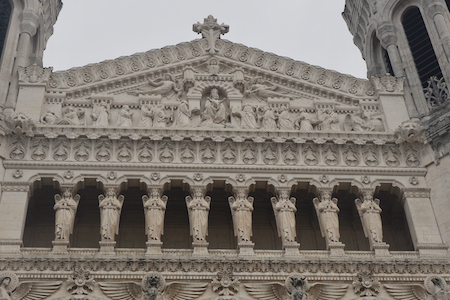
Upper façade
|
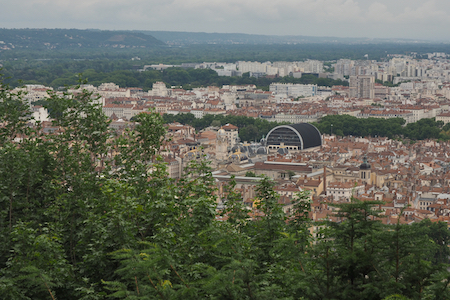
View of Lyon from Fourviere Hill - note the "Toaster" |
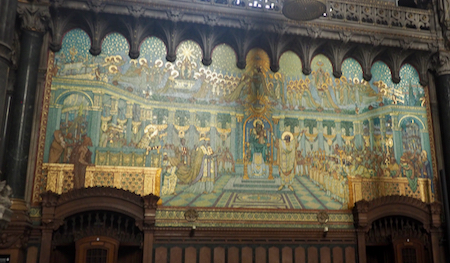
Cathedral interior |
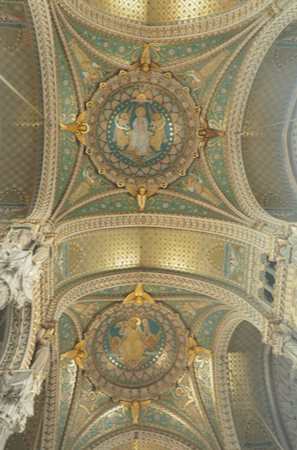
Cathedral ceiling
|
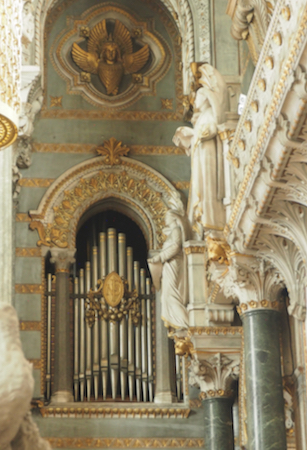
The organ
|
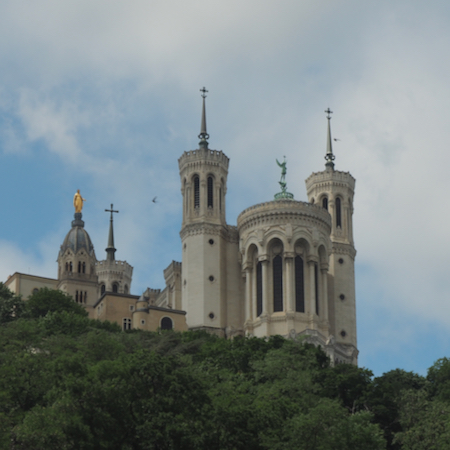
Cathedral from outside and below
|
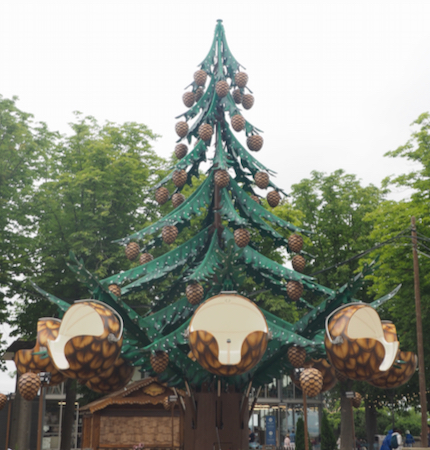
Interesting amusement ride in the Cathedral area
|
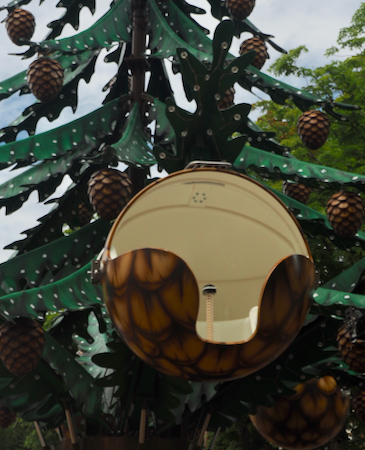
Individual "seat" |

Tower of Fourvière - Lyon's Eiffel Tower |
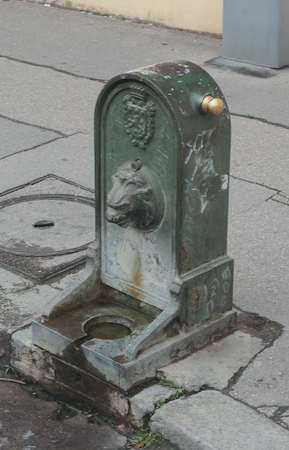
Public fountain
|
We took the funicular back down and went into the Cathedral of Sainte-Jean (St. John). It was plain after seeing the basilica but we noticed two windows that were modern design stained glass. The church also houses a Horloge Astronomique, an astronomical clock. As usual, all the information about the clock was only in French so it was difficult to appreciate.
|
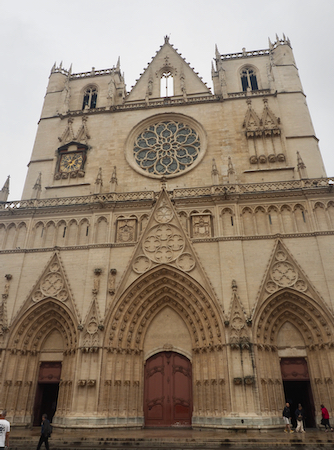
Cathedral of Sainte-Jean
|
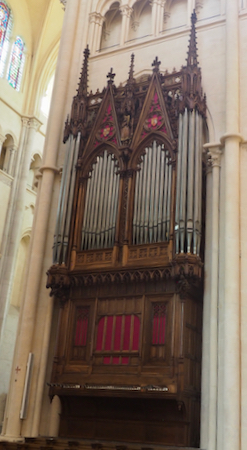
The organ
|

More organ
|
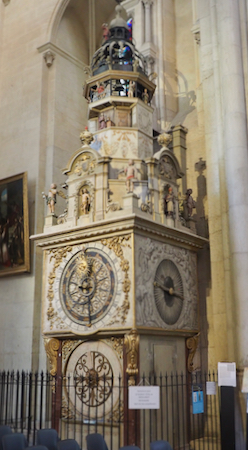
Astronomical Clock |
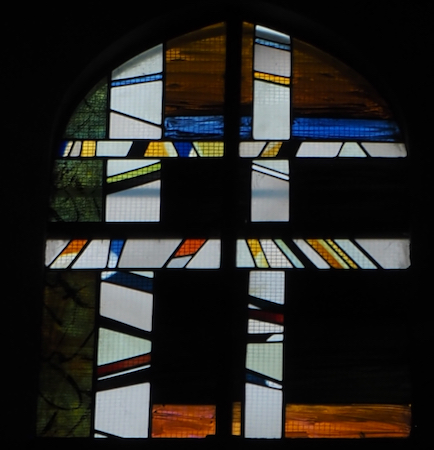
Modern stained glass windows
|
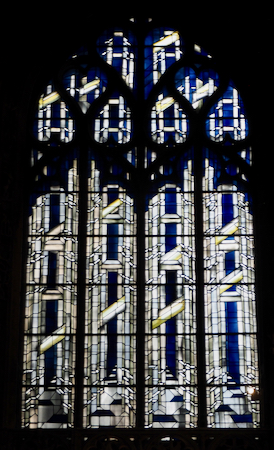
Modern stained glass windows
|

Ruins behind the Cathedral of Sainte-Jean
|
Adjacent to St. Jean cathedral (on the northern side), a lovely archaeological garden contains the remains of the religious buildings which occupied the site before the cathedral was erected. The oldest remains date back to the 4th century (baptistery of the former St. Etienne church).
|





























































